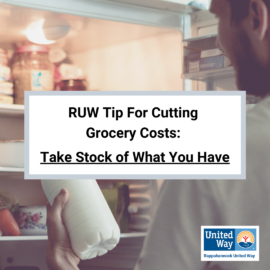By Melody Fowler
In the middle of the current pandemic our budgets are feeling the squeeze. In addition, food prices are going up due to shortages as food manufactures grapple with keeping their workforces healthy. Some of these changes include learning how to order groceries online for deliver/pickup, wearing a mask to the store, and trying to follow one-way arrows in certain stores. This makes finding certain staples (toilet paper) almost impossible to find. The need to plan ahead is even more important now in successfully stretching your budget. Remember, when you’re able to take control of small tasks, like meal planning or creating a grocery list, it makes larger tasks, like staying within your budget, less daunting. To help stretch the budget when shopping for groceries here are some strategies to consider.
 Take Stock of What You Have
Take Stock of What You Have
It is important to know what you have so that you can purchase items you need and not accidently purchase duplicate items you already have. Begin by creating a list of what food you have in the fridge, freezer, and pantry. As you make your list be sure to include quantities. Also, be sure to note expiration dates on perishable items, this will be useful when you make your meal plan.
After you have examined the contents in your fridge, freezer, and pantry consider noting which items you use the most often. Does the can of beans sit there while the bag of chips disappears? Think about which items are the most nutritious as well as affordable. For example, you can by a 5lb bag of potatoes for same price as one TV Diner. Potatoes are low in calories and a good source of Vitamin C, Vitamin B6, Manganese, Phosphorus and Niacin. Potatoes give you lots of healthy cooking options (stuffed, mashed, home fries, potato salad, and oven baked).
 Make a Meal Plan
Make a Meal Plan
Now that you know what you have, the next step is to incorporate those items into your upcoming meals. This is where creating a simple meal plan for the following week or month can really help out. Having a meal plan makes it easier to know what to prepare for the week ahead. It also helps prevent the urge to turn to ordering out which is by far the costliest meal choice. An example of a simple meal plan could include the following: breakfast, lunch, dinner, snacks. An example of a meal plan for dinners is: Marconi and Cheese on Monday, Tacos on Tuesday, Chicken Parmesan on Wednesday, Spaghetti on Thursday, and Homemade Pizza on Friday. Also, consider incorporating items that you have on-hand that will be expiring soon into your meal plan, so that your food does not go to waste. Once the meals are chosen double check to make sure you have the ingredients on hand.
Some other helpful tips include repeating the same meal schedule from a prior week and changing up the side dishes. If you know you will be short on time consider making meals ahead of time and putting them in the freezer ready to use on nights when you don’t have time to cook.
 Shop with a Grocery List
Shop with a Grocery List
Now that you have a meal plan it’s time to create a grocery list. The grocery list should be limited to items that you are going to use in your upcoming meals. Having a list will help limit impulsive purchases. When you get to the store try hard to stick to the list. If you’re on a tight budget star the items on the grocery list that will help to provide the most nutritious and cheapest meals for your household. At the grocery store pick up the starred items first. Don’t be afraid of using your cell phone calculator to make sure that you are not going over what you planned to spend at the grocery store. One last tip, try not to shop on an empty stomach as this can greatly help limit impulse purchases.
I hope these tips help you the next time you go to the grocery store.



